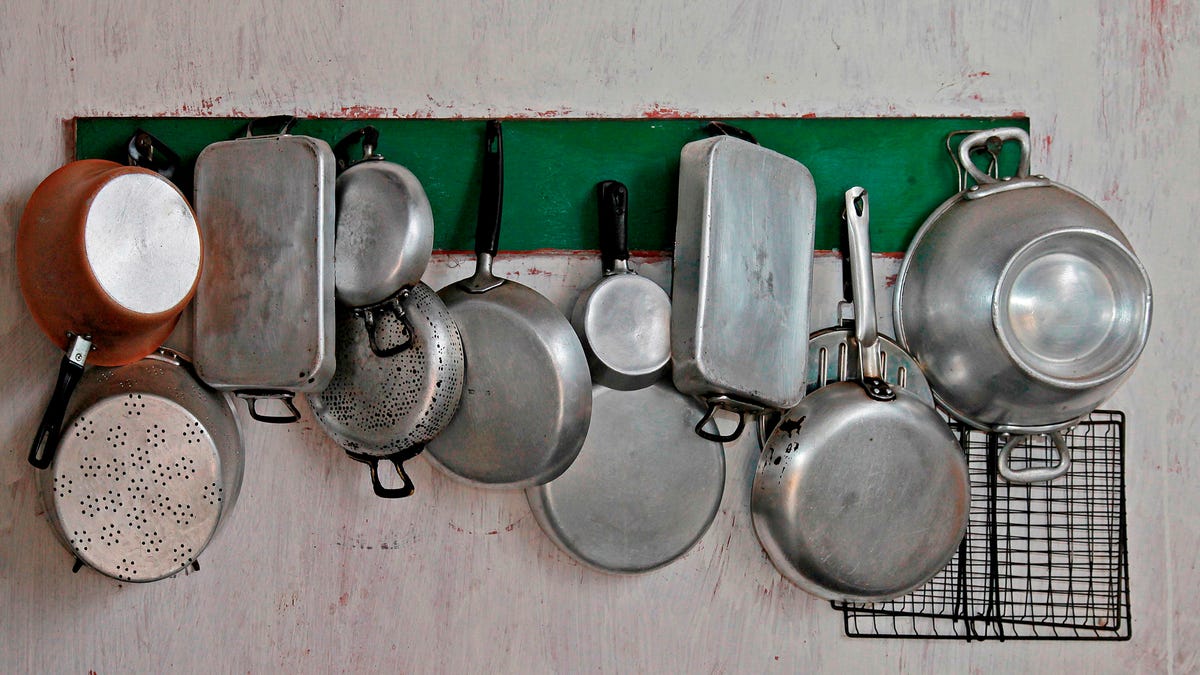 Why You Can Trust CNET
Why You Can Trust CNET How to properly store your pots and pans
Break the bad habit of stacking your cookware now.

How you store your pots and pans is important. If you're like most people, you take the easy way out. That is to stack them inside other pots and pans and throw them in the cupboard. But that's the worst thing you can do.
Why? Because you can do a lot of damage by storing your pans improperly. The inevitable bump and slide of heavy cookware leads to scratched, scuffed pans in no time.
Plus, by stacking your pots and pans, you make it difficult to track down the items you need -- if you even succeed.
Stop the madness and use one of these effective methods to organize and stash away your kitchenware properly.
Pot racks come in many forms, though all have hooks for cookware handles.
Pot racks
If your kitchen is big enough, consider hanging pans on a pot rack. These storage systems can come in many shapes and sizes. They share the same elemental design, though, a long metal bar or rack with evenly spaced hooks running across it.
Many pans already have holes for those hooks. And even the largest stock pots sport sturdy handles. Racks allow you to use that situation to your benefit. Hanging pans on a rack eliminates the danger of scrapes and dings, as long as there's enough space between items.
Plus, placing cookware on a rack puts your pans out in the open and always at the ready. Suitable spots for a pot rack include above kitchen islands and along walls over the sink.
Pros
Pot racks create additional storage in your kitchen.
Cons
Because pot racks hold a lot of weight, you'll need to mount one to the studs in your ceiling or use wall anchors.
Celebrity chef Julia Child and her husband, Paul Child, at home. Notice the cleverly hanging pots and pegboard behind them.
Wall-mounted pegboards
Kitchen real estate and storage tight? Mounting a pegboard to wall is another way to go.
Essentially, pegboards are flat sections of wood or metal perforated with numerous holes or slots. You insert special hooks into these holes, then hang cookware onto them as required.
Pegboards are great for turning unused wall space into an instant spot for pots, pans, and utensils. If it was good enough for Julia Child, it's good enough for the rest of us.
Pros
Pegboards offer lots of room to store pots, pans, lids and utensils.
Cons
They need plenty of unused wall space.
Pan protectors nestle between your pots and pans to prevent scratches.
Pan protectors
You can still stack your pans so long as you place a protective layer between them. One method is to use paper towel or a dish towel as a barrier between stacked cookware.
You can also buy products specifically made for this purpose. Typically, they're spongy pads with undersides that grip to resist slips and slides that cause scratches. The protectors function as padded cushions that dampen damaging shocks or bumps.
Pros
Pan protectors are simple to use and can be made out of stuff that's already in your kitchen.
Cons
You still need to hide your cookware inside cupboards.
Wood, plastic or glass: What kind of cutting board is best?
Does your kitchen need a makeover? Here are nine easy, cheap ways to upgrade your kitchen.

